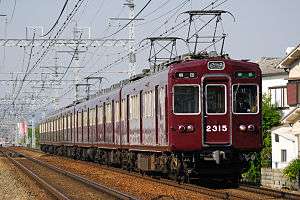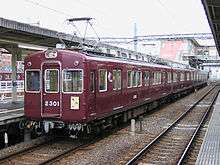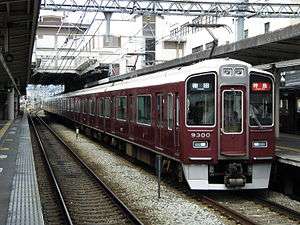Hankyu 2300 series
The Hankyu 2300 series (阪急電鉄2300系) was an electric multiple unit (EMU) train type operated in Japan by the private railway operator Hankyu Railway from 1960 until March 2015.
| Hankyu 2300 series | |
|---|---|
 A 2300 series on a Semi-express service, April 2007 | |
| In service | 1960–2015 |
| Manufacturer | Naniwa Kōki |
| Family name | Auto Car |
| Number built | 78 vehicles |
| Number in service | None |
| Number preserved | 2 vehicles and 1 cab end |
| Number scrapped | 75 vehicles |
| Formation | 7 (formerly 2/3/4/5/6) cars per trainset |
| Operator(s) | Hankyu Railway |
| Depot(s) | Katsura |
| Line(s) served | Hankyu Kyoto Main Line Hankyu Senri Line |
| Specifications | |
| Car body construction | Steel |
| Car length | 19,000 mm (62 ft 4 in) |
| Width | 2,808 mm (9 ft 2.6 in) |
| Height | 4,120 mm (13 ft 6 in) |
| Doors | 3 pairs per side |
| Maximum speed | 110 km/h (70 mph) |
| Traction system | Field chopper control |
| Power output | 150 kW (200 hp) per motor[1] |
| Electric system(s) | 1,500 V DC overhead catenary |
| Current collection method | Pantograph |
| Braking system(s) | Regenerative brake Electro-pneumatic brake |
| Safety system(s) | ATS |
| Coupling system | Knuckle-Type |
| Track gauge | 1,435 mm (4 ft 8 1⁄2 in) |
Formations
| Car No. | 1 | 2 | 3 | 4 | 5 | 6 | 7 |
|---|---|---|---|---|---|---|---|
| Designation | Mc | M' | To | Mo | M' | T | Tc |
| Numbering | 2300 | 2330 | 2350 | 2300 | 2330 | 2380 | 2350 |
- The "Mc" and "Mo" cars were each fitted with two lozenge-type pantographs.
Interior
Passenger accommodation consisted of longitudinal bench seating throughout.
- Interior
 Laurel Prize Award plaque
Laurel Prize Award plaque
History
Construction of the trains began in 1960.[1] The Hankyu 2300 series was the recipient of the inaugural Laurel Prize presented by the Japan Railfan Club in 1961.[2] The final set in service operated until 20 March 2015.[3]
 2300 series train in original style, March 2005
2300 series train in original style, March 2005
Preserved examples
- 2301 + 2352: Shōjaku Depot, Osaka
- 2311 cab end: Privately preserved in Sanda, Hyōgo.
gollark: You know, it might be possible to write some sort of program to automatically optimize busy-beavers for a given language and length.
gollark: Communism?
gollark: I forgot that Python would stringify integers if you `print`ed them.
gollark: Oh, right, it doesn't have to be a string, silly me.
gollark: Maybe I could make a HQ9+ extension for this useful task.
References
- Harris, Ken, ed. (2005). Jane's World Railways 2005-2006 (47th ed.). Jane's Information Group. p. 291. ISBN 0 7106 2710 6.
- "ブルーリボン賞・ローレル賞" [Blue Ribbon Award・Laurel Prize]. jrc.gr.jp (in Japanese). Japan Railfan Club. Archived from the original on 22 August 2016. Retrieved 17 June 2020.
- 阪急電鉄2300系引退でイベント [Hankyu 2300 series retirement events]. Tetsudo Hobidas (in Japanese). Japan: Neko Publishing Co., Ltd. 13 February 2015. Archived from the original on 17 June 2020. Retrieved 13 February 2015.
Further reading
- Shinohara, Susumu (May 2015). 阪急2300系の55年 [55 years of the Hankyu 2300 series]. Japan Railfan Magazine (in Japanese). Vol. 55 no. 649. Japan: Koyusha Co., Ltd. pp. 100–107.
| Wikimedia Commons has media related to Hankyu 2300 series. |
This article is issued from Wikipedia. The text is licensed under Creative Commons - Attribution - Sharealike. Additional terms may apply for the media files.
